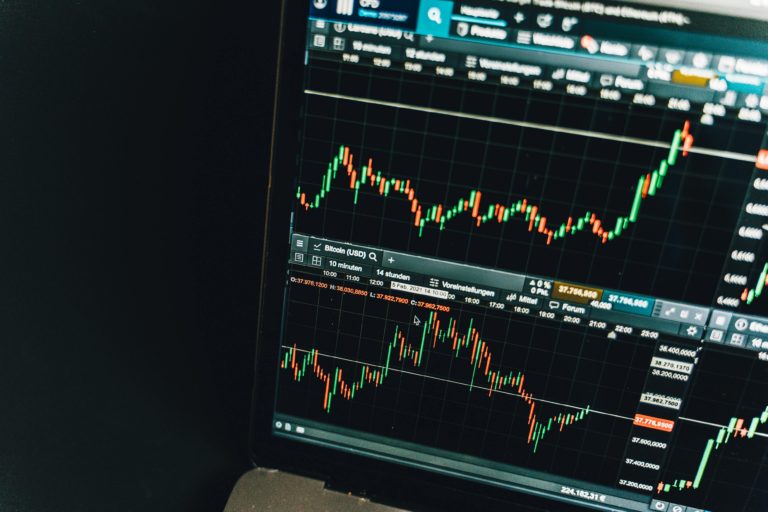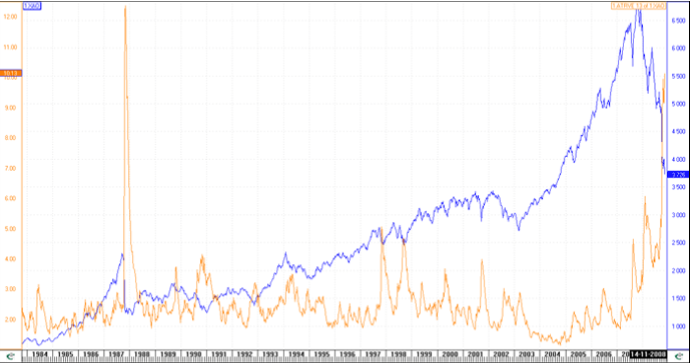
One of the biggest challenges facing traders and investors today is extreme market volatility. It’s not just limited to share market indexes either; futures, currencies, and commodity markets are all experiencing sharp swings as uncertainty and fear grip global economies.
Whether you’re trading during volatility or investing for the long term, the emotional rollercoaster can be hard to manage. Traders, even seasoned ones, may act irrationally, jumping in and out of trades based on headlines, rumors, or gut feel. And while short-term traders might profit from these wild moves, they’re also contributing to the instability.
Let’s take a breath and look at how to approach volatile markets with a clear head and a solid plan.
Understanding What Volatility Looks Like
To put current conditions into perspective, examine the chart of Australian equity markets. Volatility, measured in percentage terms, is approaching levels not seen since the 1987 crash: just over 12% back then, and currently hovering around 10%.
For comparison:

- 1997 correction: ~5.5%
- Post-9/11 selloff: just over 4%
These numbers highlight just how intense today’s swings are. For many newer traders who entered the market during the relatively calm bull run from 2003 to 2007, this feels like an unfamiliar territory.
And it shows. Many are frozen, like deer in the headlights, unsure of what to do next.
But here’s the good news: market volatility isn’t permanent. It comes in waves, and eventually, things stabilize.
Following the 1987 crash, it took approximately eight months for volatility to return to its pre-crash levels. That crash was sharper and faster, occurring over just two days, while today’s downturn has unfolded more gradually.
Still, waiting for “normal” to return without a plan is dangerous.
How to Trade in Volatile Markets: 6 Practical Ways
Feeling overwhelmed? You’re not alone. Volatile markets can make even experienced traders second-guess their decisions.
The good news is, you can trade confidently through chaos if you stick to a plan and keep your emotions in check.
Here’s a detailed breakdown of how to do just that:
1. Use a Rules-Based Strategy
One of the reasons why most traders fail in volatile markets is entering them without a plan. They rely on gut feelings, social media chatter, or the latest news headline. But volatility demands discipline, not improvisation.
That’s why rules-based systems, like the SPA3, are so effective. These systems are designed to override emotions from the equation. They provide clear entry and exit rules, based on technical signals and risk assessments, not on “what feels right.”
In chaotic markets, this matters more than ever. When you’re staring at massive intraday swings, your brain will scream at you to act. But systems like SPA3 give you the framework. You’re following time-tested rules that have stood the test of time.
Pro Tip: Keep your trading journal open. Every decision should be traceable to a rule in your system, not a hunch or headline.
2. Reduce Your Position Size
It’s tempting to go all-in when you see big price moves. But in volatile conditions, that’s a fast track to blowing up your account. Instead, scale down your position size to account for the increased volatility.
A position that would usually result in a 2% loss can now wipe out 10% if you’re not careful. By trading smaller, you give yourself more breathing room and reduce the burden of watching your account swing wildly.
Even professional traders cut their size during high-volatility periods. It’s essential for survival.
Pro Tip: Use the Average True Range (ATR) to assess how much a stock or index is moving. Adjust your position size accordingly.
3. Tighten Your Risk Management
Now’s not the time to be loose with your risk. Risk management in trading is your #1 defense against the chaos of the market.
Set your stop-loss levels before you place a trade, and stick to them. Don’t widen them just because you “feel” the market might reverse. And more importantly, only risk a small portion of your capital on each trade, generally no more than 1-2%.
Your stop-loss and position size should work together. In volatile markets, wider stops may be needed to avoid getting shaken out, but that means your position size should be even smaller to keep your total risk in check.
Pro Tip: Risk is not just about how much you could lose on one trade. It’s also about how exposed your entire portfolio is to market conditions. Look at the big picture.
4. Check the Market’s Risk Level Before Entering
Before placing any trade, ask yourself: Is the overall market in a HIGH-risk state or a LOW-risk state?
If you’re not using a market risk filter, you’re trading blind. Systems like SPA3 help investors stay out of the market when risk is elevated and only re-enter when conditions become more favourable. This is one of the most overlooked tools in a trader’s kit.
High-risk market environments can invalidate even the best setups. Price signals become unreliable, and volatility turns the market into a noise machine. That’s why having a market risk indicator in your strategy is essential; it tells you whether you should even be trading at all.
Pro Tip: You don’t always need to be in the market. Sometimes, the best trade is to sit out.
5. Avoid News-Based Trading
News is everywhere, and during volatile times, it’s louder than ever. But here’s the truth: news-based trading is subjective, emotional, and unreliable.
Headlines are designed to grab attention, not to help you trade. By the time you react to a news story, the market has often already priced it in, or worse, overreacts and whips back just as fast.
Think of your trading rules and systems as trading belts; they keep everything secure when the market gets shaky. A rules-based system like SPA3 filters out this noise by sticking to objective signals. You don’t need to predict what the news will say or how the market will interpret it. You just follow your system.
Pro Tip: Turn off the TV. Unfollow the doomsayers on X. Focus on the chart, your rules, and your execution.
6. Plan Your Re-Entry Now
Volatility doesn’t last forever. Eventually, the storm passes. But if you wait until things feel safe to plan your comeback, you’ll be too late.
That’s why it’s crucial to prepare your re-entry strategy in advance. When the market risk level drops and conditions stabilize, you’ll want to re-engage with clarity, not hesitation.
Mechanical investors using systems like SPA3 don’t guess when to return. They watch for LOW-risk signals, followed by high-probability entry points. These signals come from the system, not from emotion or market “feel.”
Having a recovery plan is what separates professionals from amateurs. When the fog lifts, you’ll know exactly what to do.
Pro Tip: Write out your re-entry rules and conditions in your trading plan now. Don’t wait until you’re in the heat of the moment.
Preparing for the Rebound
Knowing how to step back into the market when things settle is just as important as knowing when to step out. When the risk drops and volatility fades, prepared traders will re-enter with confidence and clarity, while others hesitate and second-guess.
Mechanical investors using systems like SPA3 will recognize the LOW-risk signal from their market indicators. Trade signals will begin to appear, and positions will be sized appropriately. This disciplined re-engagement gives them a much-needed edge.
Check out this case study on how SPA3 users navigated drawdowns and confidently re-entered the market as conditions shifted from high risk to low.
Final Thoughts: Stay in Control, Not in Fear
In volatile times, fear can be your worst enemy. But it doesn’t have to be. With the right strategy, clear rules, and a commitment to smart risk management in trading, you can weather the storm and come out stronger on the other side.
Frequently Asked Questions
1. What is the biggest mistake traders make during volatile markets?
The most common mistake is abandoning a proven strategy and reacting emotionally to price swings or headlines. This often leads to entering and exiting positions at the worst possible times. A rules-based approach helps avoid this trap.
2. Should I stop trading completely when markets are volatile?
Not necessarily. The key is to adjust your risk by reducing position size, tightening risk controls, and using a market risk filter. Sometimes, however, sitting out until conditions improve is the smartest move.
3. How do I know if the market is in a high-risk state?
Market risk can be assessed using objective indicators, such as volatility levels, market breadth, and trend filters. Systems like SPA3 use these to signal when the environment is too risky for new entries.
4. Can news trading work during volatile periods?
It’s possible, but highly risky. Markets often react before you can trade, and price action can reverse sharply after the initial move. In most cases, it’s better to rely on predefined technical rules instead of reacting to news.
5. How can I prepare for a market rebound?
Write down your re-entry rules in advance. When your market risk filter signals a low-risk state, follow your system’s entry signals. This ensures you re-enter with discipline rather than hesitation.
